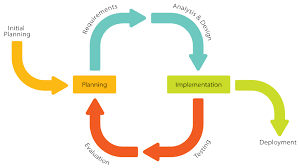Iterative and Incremental Development: The Key to Successful Software Projects
In the fast-paced world of software development, it is crucial to have an approach that allows for flexibility, adaptability, and continuous improvement. This is where iterative and incremental development comes into play. This methodology has gained popularity in recent years due to its ability to deliver high-quality software solutions while accommodating changing requirements.
So, what exactly is iterative and incremental development? It is an approach that breaks down the development process into smaller, manageable chunks called iterations. Each iteration involves a complete cycle of planning, designing, developing, testing, and delivering a working increment of the software. The key aspect here is that each iteration builds upon the previous one, gradually improving the product.
One of the major advantages of this approach is its ability to accommodate changing requirements. In traditional waterfall development methodologies, requirements are typically fixed at the beginning of a project. However, in today’s dynamic business environment, requirements often change as stakeholders gain new insights or market conditions evolve. With iterative and incremental development, these changes can be easily incorporated into subsequent iterations without disrupting the entire project timeline.
Another benefit of this methodology lies in risk management. By breaking down the project into smaller iterations, risks are identified early on and can be addressed promptly. This reduces the chances of major setbacks or failures later in the development process. Additionally, regular feedback from stakeholders during each iteration allows for continuous improvement and course correction if necessary.
Furthermore, iterative and incremental development promotes collaboration and transparency among team members and stakeholders. Since each iteration results in a working increment of the software, it enables frequent demonstrations and discussions about progress. This fosters open communication channels where feedback can be shared and incorporated promptly.
It’s important to note that iterative and incremental development does not mean sacrificing quality for speed. On the contrary, by focusing on delivering working increments at regular intervals, teams can continuously test their product for bugs or issues early on. This leads to higher quality software as issues are identified and resolved swiftly, preventing them from accumulating and causing significant problems later.
In conclusion, iterative and incremental development has emerged as a powerful methodology for software projects. Its ability to adapt to changing requirements, manage risks effectively, promote collaboration, and maintain high-quality deliverables makes it an attractive choice for modern development teams. By embracing this approach, organizations can increase their chances of success in delivering software solutions that meet the evolving needs of their customers.
Understanding Iterative and Incremental Development: Frequently Asked Questions
- Which is iterative and incremental model?
- What is the difference between iteration and increment?
- What does iterative development mean?
- What is the difference between incremental and iterative delivery?
Which is iterative and incremental model?
One example of an iterative and incremental model is the Agile software development methodology. Agile methodologies, such as Scrum or Kanban, follow an iterative and incremental approach to software development.
In Agile, the development process is divided into short iterations called sprints. Each sprint typically lasts for a few weeks and focuses on delivering a working increment of the software. The requirements are gathered at the beginning of the project but are subject to change throughout the development process. The team works collaboratively to plan, develop, test, and deliver a functional piece of software at the end of each sprint.
At the start of each sprint, the team selects a set of prioritized requirements from a product backlog. These requirements are broken down into smaller tasks that can be completed within the sprint duration. The team then works on these tasks in a time-boxed manner, often having daily stand-up meetings to discuss progress and address any obstacles.
At the end of each sprint, there is a review meeting where stakeholders can see the working increment and provide feedback. This feedback is then incorporated into subsequent sprints, allowing for continuous improvement and adaptation based on changing requirements or market conditions.
The Agile methodology emphasizes close collaboration between team members and stakeholders throughout the development process. It promotes transparency, adaptability, and regular feedback loops to ensure that the final product meets customer expectations.
It’s worth noting that while Agile is one popular example of an iterative and incremental model, there are other models that also follow similar principles. Some examples include Rapid Application Development (RAD), Dynamic Systems Development Method (DSDM), and Extreme Programming (XP). These models share common characteristics in terms of iterative development cycles and incremental delivery but may have different approaches or variations in their implementation.
What is the difference between iteration and increment?
In the context of iterative and incremental development, “iteration” and “increment” are two distinct concepts that work together to achieve the overall goal of delivering a software solution.
An iteration refers to a complete cycle or loop within the development process. It involves planning, designing, developing, testing, and delivering a working increment of the software. Each iteration typically has a fixed duration, such as two weeks or one month, and focuses on completing a specific set of tasks or features. The purpose of an iteration is to make progress towards the final product by continuously building upon previous iterations.
On the other hand, an increment refers to the result or outcome of each iteration. It represents a tangible addition or enhancement to the software that provides value to users or stakeholders. An increment can be a new feature, functionality improvement, bug fix, or any other deliverable that contributes to the overall development process. The key aspect of an increment is that it is usable and potentially releasable on its own.
To put it simply, an iteration is the process or cycle through which work is completed in smaller chunks over time. An increment is the actual output or outcome of each iteration that adds value and contributes to the overall development progress.
In iterative and incremental development, multiple iterations are performed sequentially, with each iteration building upon previous increments. This approach allows for regular feedback and continuous improvement while accommodating changes in requirements throughout the project lifecycle. By breaking down the work into manageable iterations and delivering usable increments at regular intervals, teams can ensure progress while maintaining flexibility and adaptability in their development process.
What does iterative development mean?
Iterative development is an approach to software development where the project is divided into smaller cycles or iterations. Each iteration involves completing a set of tasks, such as planning, designing, developing, testing, and delivering a working increment of the software. The key aspect of iterative development is that it allows for continuous improvement and refinement of the software through multiple iterations.
In this approach, the development team focuses on delivering a functional subset of the software during each iteration. This means that at the end of each cycle, there is a tangible and usable increment of the product. This iterative process continues until the desired final product is achieved.
The main idea behind iterative development is to break down complex projects into manageable parts. By doing so, it becomes easier to manage risks, adapt to changing requirements, and incorporate feedback from stakeholders throughout the development process. Each iteration builds upon the previous one, allowing for incremental improvements and adjustments based on feedback and lessons learned.
Iterative development offers several benefits. It promotes flexibility by accommodating changes in requirements or priorities as they arise. It also enables early detection and resolution of issues or bugs since testing occurs at regular intervals. Additionally, it fosters collaboration among team members and stakeholders through frequent demonstrations and discussions.
Overall, iterative development provides a structured yet adaptable approach to software development. It emphasizes continuous improvement, customer feedback, and incremental delivery of working software increments throughout the project lifecycle.
What is the difference between incremental and iterative delivery?
Incremental and iterative delivery are two distinct approaches in software development, although they are often used together. Here’s a breakdown of their differences:
1. Incremental Delivery:
Incremental delivery focuses on delivering the software in small, incremental pieces or increments. Each increment represents a functional subset of the overall system that can be delivered and potentially used by end-users. The increments are typically planned and prioritized based on their value or importance to stakeholders.
The key characteristics of incremental delivery include:
– Delivering usable functionality in regular intervals, often referred to as releases.
– Each release adds new features or enhancements to the previous release.
– The increments are typically defined based on user needs or business priorities.
– Feedback from users and stakeholders is collected after each release to guide subsequent increments.
The primary goal of incremental delivery is to provide early value to users while allowing for continuous improvement through subsequent releases.
2. Iterative Delivery:
Iterative delivery, on the other hand, focuses on breaking down the development process into iterations or cycles. Each iteration involves a complete cycle of planning, designing, developing, testing, and delivering a working increment of the software. The key aspect here is that each iteration builds upon the previous one, gradually improving the product.
The key characteristics of iterative delivery include:
– Developing and refining the software through multiple iterations.
– Each iteration aims to add more functionality or improve existing features.
– Feedback from users and stakeholders is collected at the end of each iteration for reflection and adjustment.
– Changes based on feedback may be incorporated into subsequent iterations.
The primary goal of iterative delivery is to continuously refine and enhance the software based on feedback obtained during each iteration.
In practice, these two approaches often go hand in hand. Incremental delivery provides value by delivering usable increments at regular intervals, while iterative delivery allows for continuous improvement by refining those increments through multiple iterations. The combination of both approaches facilitates flexibility, adaptability, and the ability to incorporate changes as the project progresses.




